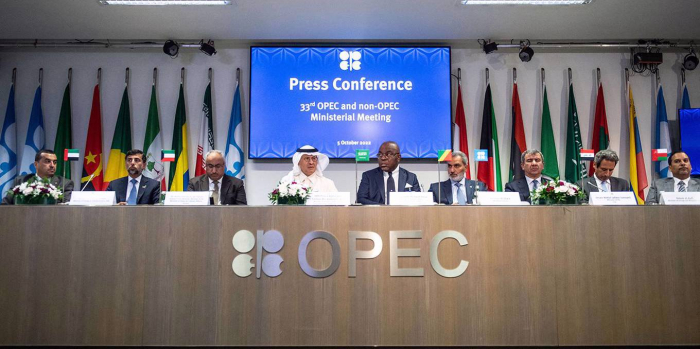In the short term, Western countries seeking to counter the Kingdom's swing-producer power could release additional strategic reserves and increase shale oil production. In the medium term, however, the West is left with little choice but to accelerate the shift away from fossil fuels.
The OPEC+ oil producers, led by Saudi Arabia and Russia, surprised markets earlier this month by deciding to cut production by two million barrels per day – roughly the equivalent of 2% of the global supply. The decision, which briefly sent Brent crude climbing toward $100 per barrel, signaled the cartel’s resolve to boost prices in the face of a faltering global recovery. That put US President Joe Biden in a precarious position ahead of next month’s midterm elections. But it also demonstrated Saudi Arabia’s growing willingness to resume its swing-producer role and highlighted its newfound alignment with Russia.
The increase in oil prices following Russia’s invasion of Ukraine, together with limited spare capacity, has made the cohesion of OPEC+ necessary and spurred its members to coordinate collective production targets more effectively. But cohesiveness alone cannot preserve the cartel’s role as global price-setter. That role depends on the Kingdom’s willingness to resume its traditional function as the market’s swing producer, which it has been reluctant to carry out in recent years.
While the OPEC+ decision threatens to place additional strain on the relationship between the United States and Saudi Arabia, the production target is mostly illusory. The new agreement sets the cartel’s November output at around 42 million barrels per day, but it already produces about 39 million barrels per day – 4.5 million below the official October target – as 15 of the group’s 23 members struggle to meet their quotas.
The discrepancy between targeted and actual production has widened over the last few months. Most countries – apart from Saudi Arabia and the United Arab Emirates – lack spare capacity, owing to years of underinvestment. This is particularly true of Nigeria and Angola. Moreover, Western sanctions’ effect on Russian exports has only been partly attenuated by diverting deliveries from Europe to Asia.
As a result, OPEC+ will most likely reduce production by one million barrels per day in November – half of the cut the group suggested in Vienna this month. The member countries that are already struggling to keep pace with output targets will most likely not cut production at all, thus bringing the target closer to the alliance’s actual capacity.
This month’s decision requires just eight OPEC+ countries to reduce oil production, with Saudi Arabia expected to shoulder much of the burden by cutting output by 500,000 barrels per day. Similarly, when OPEC+ slashed production by nearly ten million barrels per day during the pandemic to offset plummeting demand, Saudi Arabia voluntarily cut its production by an additional one million barrels per day beyond its group commitment.
But the Saudis have probably learned from their past mistakes. In the 1980s and 1990s, the Kingdom was the undisputed leader of a cartel plagued by cheating and infighting. But during the 2008 global financial crisis, the country refused to play the swing-producer role by adjusting its own production to maintain high prices. With OPEC’s oligopolistic power eroded following the US shale-energy revolution, the Saudis feared that American producers would benefit from higher oil prices and expand their market share at the Kingdom’s expense.
As a result, oil prices dropped from almost $110 a barrel to $29 between 2014 and early 2016, leaving every OPEC member worse off. As the public finances of traditional oil producers deteriorated, Saudi Arabia was forced into an uncomfortable alliance with Russia, a longtime ally of the Kingdom’s archenemy, Iran. The enlarged cartel hurt US shale producers’ profitability but failed to drive them from the market. The Russians and the Saudis struggled to form a common front and agree on a joint production strategy, resulting in an unprecedented price war that pushed the West Texas Intermediate benchmark deep into negative territory in the spring of 2020.
To be sure, Saudi Arabia’s willingness to act as a swing producer is driven by pure self-interest. However fictitious they may be, the recent production cuts aim to shift the market narrative away from demand destruction toward undersupply and to set a price floor of $90 a barrel. But pushing oil prices higher would also undermine US attempts to cap the price of Russian oil, which the Saudis view as a dangerous precedent. After all, if Western countries leverage their demand power to impose price caps on oil from Russia, they could conceivably do the same to oil from the Middle East.
Consequently, Saudi Arabia may seek to consolidate its swing-producer role for the long term. The green transition will most likely lead to a structural decline in oil demand that would require the sort of swift output adjustments that only the Kingdom can coordinate and implement. OPEC+ members would expect the Saudis to lead by example and make greater sacrifices to offset surpluses and prevent prices from collapsing. But Saudi Arabia could also force them to cooperate by using its spare capacity to push down prices.
Western countries seeking to counter Saudi Arabia’s swing-producer power have few good options. In the short term, they could release additional strategic reserves and increase shale oil production, which would require additional investment but may bring some price relief. In the medium term, however, the West is left with little choice but to accelerate the shift away from fossil fuels.
Edoardo Campanella, Senior Fellow at the Mossavar-Rahmani Center for Business and Government at the Harvard Kennedy School, is co-author (with Marta Dassù) of Anglo Nostalgia: The Politics of Emotion in a Fractured West (Oxford University Press, 2019).
More about:
















































